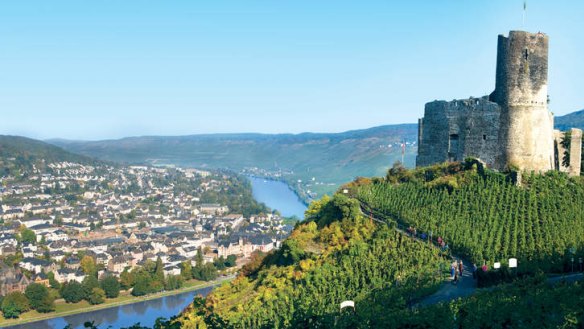Sun and slate secret to Mosel wine
Minerality aside, it is their delicacy and fineness that make Mosel wines great.

Touring the wine regions of the Mosel and Rhone valleys in Germany, it's hard not to be seduced by the fairytale beauty of the villages, the houses and the castles.
The roofs of almost all the buildings are tiled with grey slate, each tile cut to a rounded shape and arranged like scales on a fish. It's slate that makes the vineyards and the wines unique.
There's not much risk of the tiler's art dying out, because they are kept busy by hailstorms. In the village of Lieser, in the upper Mosel, a hailstorm in 2011 smashed the tiles on many houses, and they had no sooner been repaired when another struck in 2013 and smashed them again. They are still being repaired, and workmen with a crane were working on the roof of Thomas Haag's Schloss Lieser winery buildings when I visited him a couple of weeks ago. You do spare a thought for the tilers' safety, though, when you see how high and steeply pitched many of the roofs are.
Every winemaker in the region waxes lyrical about the slate, not on the roofs but in the vineyards. The Mosel boasts some of the world's steepest and most spectacular vineyards, and the steeper they are, the better. The vineyards that have the most direct southern exposure, the steepest angle to best intercept the sun's rays, and the most slate to store the heat, produce the best wines.
As Hugh Johnson wrote so memorably in his first World Atlas of Wine, the Mosel wriggles like a worm on a hook, so that the south-facing slope varies in a few kilometres from the left bank to the right, and back again to the left. You learn very quickly that great wine here is all about solar exposure.
Sun and slate are the Mosel's secrets. The grey slate, which varies from blue-grey to reddish in parts, can be several metres deep beneath the (unirrigated) vines, whose roots delve deep in search of moisture. These deep roots in turn afford insurance for the vine against water stress during dry periods. The side benefit is that the deeper the roots go (and they've been measured 15 metres deep in some vineyards), the more layers of rock and soil they encounter.
Winemakers such as Johannes Selbach, of Selbach-Oster, believe the more subsoil strata the roots access, the more ''mineral'' and complex the resulting wine is.
This is why irrigated vines don't have the same minerality, says Rowald Hepp, of Schloss Vollrads, which is actually in the Rheingau, but also has slatey soils.
There are only a few great viticultural regions in the world that have slatey soils: other parts of Germany, such as bits of the Rheinpfalz; parts of Austria's Wachau region; parts of Alsace; and Australia's Polish Hill River - a subregion of the Clare Valley. What is common to all of these regions is the riesling grape.
Because the winegrowers of Clare irrigate their vines, their vine roots don't delve deep and their wines don't have minerality, according to Selbach's line of thought.
Scientists retort that soil minerals do not get into the juice or the wine, so how can they influence the aroma and flavour of wine? It's an interesting argument that wine-lovers the world over ponder.
Winemakers such as Rowald Hepp are certain about minerality in their riesling. Wilhelm Haag, of the Fritz Haag domaine in the Mosel, made me chew a piece of slate in the Brauneberger Juffer Sonnenuhr vineyard and note how it tasted like wine.
I wasn't so sure. It tasted like dirt to me, and good wine such as Fritz Haag doesn't taste like dirt. However, the affinity of riesling for slate soils must be more than coincidence.
There was a time when the Mosel and its tributaries the Saar and Ruwer rivers were routinely described as the coldest place on earth where table wine is produced, and much was made of the ability of the slate soils to act as a heat bank to help ripen the grapes. Indeed, Oliver Haag says that in summer mid-afternoons, it can be so hot that vineyard workers are sent home, and you can fry an egg on a slate in seconds.
But climate change is putting a different complexion on that discussion, what with vines thriving in England and wine even being produced in Denmark. The Mosel is experiencing warmer temperatures, more extreme weather, earlier harvest dates and riper grapes than ever before.
As Thomas Haag says, the challenge is to preserve the typical Mosel style of riesling, which is all about delicate, racy wines with high acidity, low alcohol, balanced sweetness and a beautiful purity of fruit. Alcohol strengths are typically about 9 or 10 per cent, and as low as 7 for sweeter grades.
These are unique wines, great wines. I hope they continue to be delicate and fine, not heavy and alcoholic. The world is awash with big, full-bodied, high-alcohol wines, but refreshing, stimulating wines of low-alcohol deliciousness such as the Mosel-Saar-Ruwer produces are a rarity. As Ernie Loosen, of Dr Loosen, says, you can drink yourself sober with Mosel wines. Or as Oliver Haag says, they are wines for ''reverse spitting''. In other words, drinking.
Recommended Mosel-Saar-Ruwer wineries: J.J. Prum, Egon Muller, Fritz Haag, Schloss Lieser, Selbach-Oster, Von Kesselstatt, Dr Loosen, Heymann-Lowenstein, Grans-Fassian, Zilliken, Clemens Busch, Max Ferd Richter, Immich Batterieberg.
